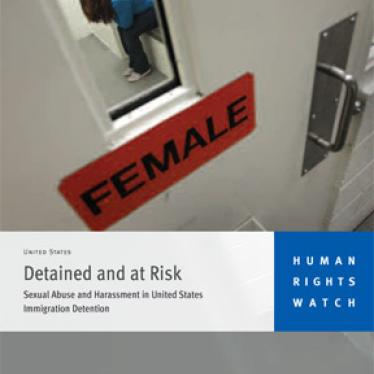President Barack Obama
The White House
1600 Pennsylvania Avenue NW
Washington, DC 20500
Re: Exclusion of Immigration Detention Facilities from Proposed PREA Standards
Dear President Obama:
The undersigned organizations write to express grave concern about a proposed rule by the Department of Justice that excludes immigration detention facilities from coverage under the Prison Rape Elimination Act of 2003 (PREA). According to the Notice of Proposed Rulemaking issued on January 24, 2011, the proposed rule would "not encompass facilities that are primarily used for the civil detention of aliens pending removal from the United States."[1]
The exclusion of immigration detention from standards on preventing, detecting, and responding to sexual assault in custody is unjustifiable. It ignores the history of sexual assault in immigration detention, is inconsistent with the intent of PREA and the administration's own efforts at detention reform, and implicates basic human rights obligations undertaken by the United States. Moreover, it threatens the safety of the hundreds of thousands of men, women, and unaccompanied children in the custody of Immigration and Customs Enforcement (ICE) or the Office of Refugee Resettlement. We urge you to instruct the Department of Homeland Security and the Department of Health and Human Services that all facilities in which immigration detainees are placed are covered under PREA. We also urge you to direct the Department of Justice to correct the serious error of excluding facilities in which immigration detainees are placed from its proposed rule.
Immigration detainees, like all persons in custody, are vulnerable to abuse. Language and cultural barriers, histories of state-sanctioned abuse in their home countries, and a fear that reporting abuse will result in deportation all increase the likelihood that a non-citizen will not feel safe reporting sexual abuse and that perpetrators will not be held accountable. Unlike criminal defendants, immigration detainees have no right to an attorney, and as a result may not be aware of their right to be free from sexual abuse, nor whom to contact if they are sexually assaulted.
The known incidents and allegations of sexual abuse in immigration detention are serious and numerous. In its 2009 report to the attorney general, the National Prison Rape Elimination Commission documented widespread reports of sexual abuse in immigration facilities over the last 20 years.[2] In August 2010 Human Rights Watch released a report compiling incidents and allegations of assaults, abuses, and episodes of harassment that have emerged across the rapidly expanding national immigration detention system.[3] These included the assaults of five women detained at the Port Isabel Service Processing Center in Texas in 2008 when a guard entered each of their rooms in the infirmary, told them that he was operating under physician instructions, ordered them to undress, and touched intimate parts of their bodies.[4] In 2009 the Women's Refugee Commission released a report that documented incidents of sexual and physical abuse of unaccompanied children in immigration custody, including the repeated sexual assaults of children at the Away From Home Texas Sheltered Care Facility in Nixon, Texas.[5]
Horror at custodial abuses like these drove the Senate and the House of Representatives to unanimously pass the Prison Rape Elimination Act of 2003.[6] The intent of PREA to include immigration detention in the measure is clear. The statute defines "prison" to mean "any confinement facility of a Federal, State, or local government, whether administered by such government or by a private organization on behalf of such government."[7] Statements in the House Judiciary Committee report emphasize the application of the statute's protections to both criminal and civil detainees.[8] Senator Edward M. Kennedy, a lead cosponsor of PREA, specifically called attention to immigration detainees in his remarks at the first hearing of the National Prison Rape Elimination Commission.[9] The exclusion of immigration facilities from PREA standards would also lead to anomalous and unjustifiable results. Under the proposed rules, an immigration detainee in a local jail would be protected by PREA but would lose that protection if transferred to an ICE facility. It is inconceivable that Congress intended PREA protection for detainees to depend on the facility that confines them.
Indeed the inclusion of immigration detention has been presumed by the National Prison Rape Elimination Commission and others charged with implementation of the act. The commission held a hearing on immigration detention during the research phase of its work and included both a section on immigration detention in its final report and an immigration detention supplement to its recommended standards.[10] At the same time, the Bureau of Justice Statistics has included immigration detention in the collection of statistics on prison rape mandated by PREA. The Department of Homeland Security itself has acknowledged the importance of the statute for its facilities. For example, in her 2009 report on the state of the immigration detention system, Dora Schriro, detention expert and then advisor to Secretary Janet Napolitano, stated, "The system must make better use of sound practices such as ... practices that comply with the [Prison] Rape Elimination Act."[11]
The failure to include immigration detention under the standards also implicates US obligations under the Convention against Torture and the International Covenant on Civil and Political Rights.[12] The International Covenant on Civil and Political Rights obligates states to ensure that "all persons deprived of their liberty shall be treated with humanity and with respect for the inherent dignity of the human person."[13] The Convention against Torture, which the US ratified in 1994, states that governments are responsible for not only acts of torture committed by government officials, but also those committed with their acquiescence.[14] In reviewing US compliance with the treaty, the Committee against Torture has expressed concern about "reliable reports of sexual assault of sentenced detainees, as well as persons in pretrial or immigration detention."[15] In addition to jeopardizing US compliance with international law, this exclusion would send a troubling message to other countries that their citizens, should they be detained in the US pending administrative immigration proceedings, will be afforded fewer protections against sexual assault than convicted criminals.
Efforts by ICE to address sexual assault through revising its own detention standards are important steps but do not obviate the need for ICE to be bound by the PREA regulations. ICE detention standards, subject to modification through collective bargaining, lack the force of law.
Finally, this error in the proposed rule undermines the administration's own efforts to reform the immigration detention system. In announcing the administration's intention to work toward a "truly civil detention system," Assistant Secretary for ICE John Morton outlined a vision of a system that would demonstrate greater respect for the dignity of individuals held in the agency's custody. Certainly that vision is incompatible with excluding detained immigrants from protections against sexual assault and abuse.
To summarize, we recommend:
- Instructing the Department of Homeland Security and the Department of Health and Human Services that all facilities in which immigration detainees are placed are covered under PREA; and
- Directing the Department of Justice to correct the serious error of excluding facilities in which immigration detainees are placed from its proposed rule.
We would welcome the opportunity to meet to discuss this further. Antonio Ginatta will be in touch with your office to arrange a meeting with our organizations. In the meantime, please feel free to contact him at 202.612.4343 or at ginatta@hrw.org.
Sincerely,
Kenneth Roth, Executive Director
Human Rights Watch
Laura W. Murphy, Director
ACLU Washington Legislative Office
Rachel B. Tiven, Executive Director
Immigration Equality
Lovisa Stannow, Executive Director
Just Detention International
Mary Meg McCarthy, Executive Director
National Immigrant Justice Center
Ali Noorani, Executive Director
National Immigration Forum
A. Frank Donaghue, Chief Executive Officer
Physicians for Human Rights
Pat Nolan, Vice President
Prison Fellowship
Sara Totonchi, Executive Director
Southern Center for Human Rights
Jim Harrington, Director
Texas Civil Rights Project
Sarah Costa, Executive Director
Women's Refugee Commission
cc: Cass Sunstein, Administrator
Office of Information and Regulatory Affairs
Cecilia Muñoz, Deputy Assistant to the President and Director of Intergovernmental Affairs
Office of Intergovernmental Affairs
[1] "National Standards to Prevent, Detect, and Respond to Prison Rape; Notice of Proposed Rulemaking," 76 Fed. Reg. 6248-6302 (February 3, 2011), http://www.ojp.usdoj.gov/programs/pdfs/prea_nprm.pdf (accessed February 15, 2011), p. 6250.
[2] National Prison Rape Elimination Commission, "Standards for the Prevention, Detection, Response, and Monitoring of Sexual Abuse in Adult Prisons and Jails: Supplemental Standards for Facilities with Immigration Detainees" (NPREC Report), June 2009, http://www.ncjrs.gov/pdffiles1/226680.pdf (accessed February 3, 2011), p. 174-188.
[3] Human Rights Watch, Detained and at Risk: Sexual Abuse and Harassment in United States Immigration Detention, August 25, 2010, https://www.hrw.org/en/reports/2010/08/25/detained-and-risk-0.
[4] Ibid., p. 8.
[5] Women's Refugee Commission, Halfway Home: Unaccompanied Children in Immigration Custody, February 2009, http://womensrefugeecommission.org/programs/detention/unaccompanied-chil... (accessed February 9, 2011).
[6] Prison Rape Elimination Act of 2003, Pub. L. 108-79, 117 Stat. 972 (2003), 42 U.S.C.A. §§ 15601-09 (Lexis 2010), http://frwebgate.access.gpo.gov/cgi-bin/getdoc.cgi?dbname=108_cong_bills... (accessed February 3, 2011).
[7] Ibid., sec. 10(7).
[8] U.S. House of Representatives Committee on the Judiciary, Report on the Prison Rape Reduction Act of 2003, 108th Cong., 1st sess., 2003, H. Rept. 108-219, http://frwebgate.access.gpo.gov/cgi-bin/getdoc.cgi?dbname=108_cong_repor... (accessed February 3, 2011), p. 14, 115.
[9] Senator Edward M. Kennedy, remarks during National Prison Rape Elimination Commission hearing, "The Cost of Victimization: Why Our Nation Must Confront Prison Rape," June 14, 2005, http://www.cybercemetery.unt.edu/archive/nprec/20090820160727/http://npr... (accessed February 3, 2011).
[10] NPREC Report, p. 174-188.
[11] Dora Schriro, ICE, DHS, "Immigration Detention Overview and Recommendations," October 6, 2009, http://www.ice.gov/doclib/about/offices/odpp/pdf/ice-detention-rpt.pdf (accessed February 3, 2011), p. 22.
[12] Convention against Torture and Other Cruel, Inhuman or Degrading Treatment or Punishment (Convention against Torture), adopted December 10, 1984, G.A. res. 39/46, annex, 39 U.N. GAOR Supp. (No. 51) at 197, U.N. Doc. A/39/51 (1984), entered into force June 26, 1987, ratified by the United States on October 21, 1994, http://www2.ohchr.org/english/law/cat.htm (accessed February 3, 2011); International Covenant on Civil and Political Rights (ICCPR), adopted December 16, 1966, G.A. Res. 2200A (XXI), 21 U.N. GAOR Supp. (No. 16) at 52, U.N. Doc. A/6316 (1966), 999 U.N.T.S. 171, entered into force March 23, 1976, ratified by the United States on June 8, 1992, http://www2.ohchr.org/english/law/ccpr.htm (accessed February 3, 2011).
[13] ICCPR, art. 10(1).
[14] Convention against Torture, art. 1(1).
[15] CAT, "Consideration of Reports Submitted by States Parties under Article 19 of the Convention, Conclusions and Recommendations of the Committee against Torture, United States of America," CAT/C/USA/CO/2, May 18, 2006, http://www2.ohchr.org/english/bodies/cat/docs/AdvanceVersions/CAT.C.USA.... (accessed February 3, 2011), para. 32.








